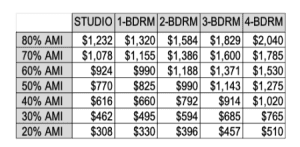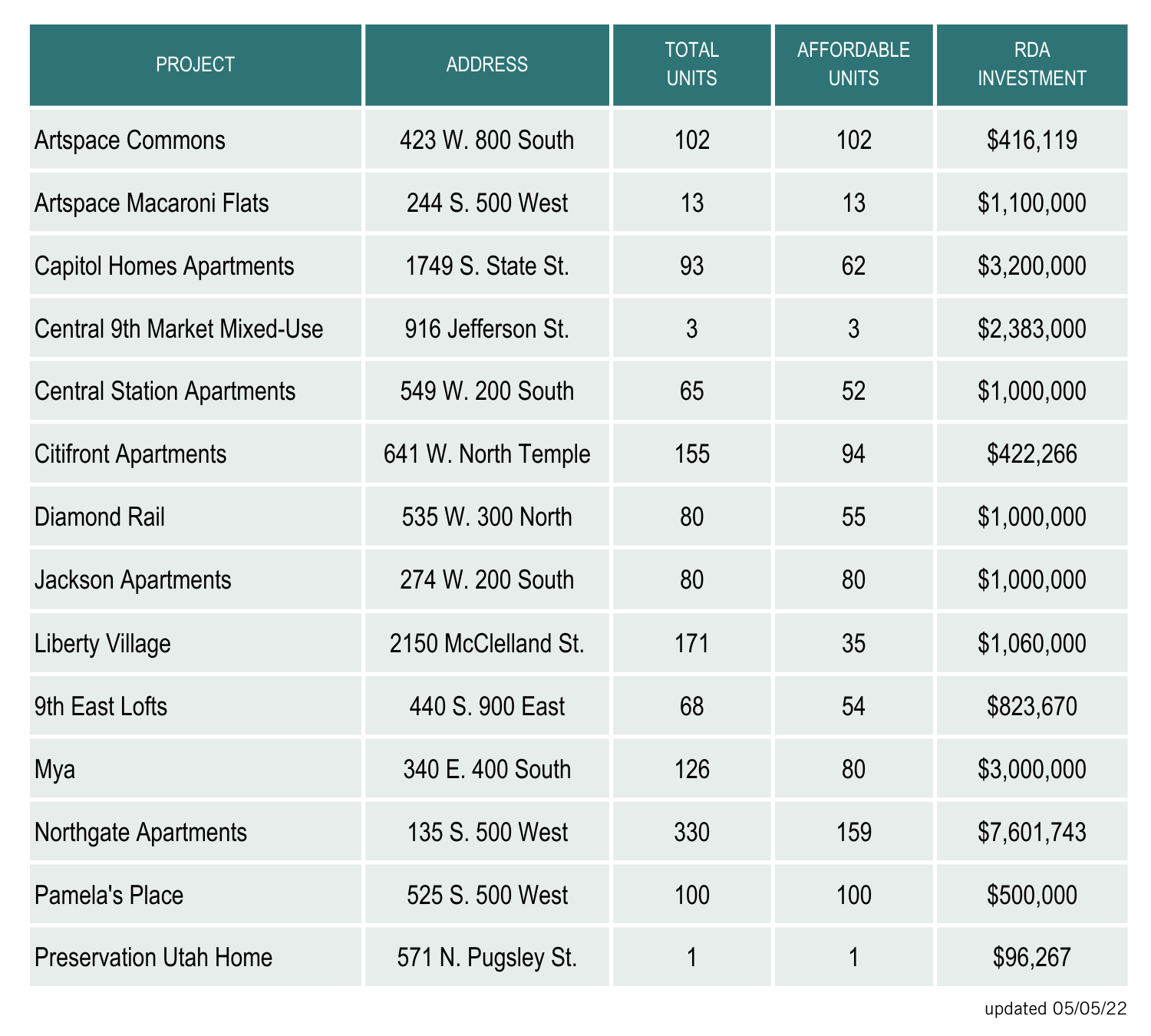
Affordable Housing
Redevelopment + Housing
The Redevelopment Agency of Salt Lake City (RDA) acknowledges that the lack of affordable housing is a crucial statewide issue and is working hard to facilitate the construction and preservation of affordable residential units in Salt Lake City. Affordable housing is the foundation of a successful city and one of the most important public benefits promoted by our mission to improve livability, foster authentic communities, and spark economic growth. It establishes stability for working families, recent college graduates, seniors, single parents, low-wage workers, and individuals experiencing homelessness, helping them work toward a better life.
Similar to cities across the country, Salt Lake City is experiencing increasing economic inequality, forcing more and more residents to spend a higher percentage of their income on housing costs. With housing costs increasing faster than incomes, it’s more difficult for residents to buy or rent a home. Inability to afford housing is the key driver of housing insecurity and increases in homelessness.
We are working alongside the Mayor’s Office, our Board of Directors (the seven members of the City Council), the City’s Housing Stability and Workforce Development divisions and community partners to address the problem and combat this trend.
Projects
As one of the City’s strongest forces in subsidizing the creation of affordable housing units, the RDA has dedicated over $70 million to affordable housing across Salt Lake City since 2010 through a variety of mechanisms, the most commonly used being:
- Providing construction and acquisition loans that serve as gap financing with below-market terms to enable the financial viability of the development of new affordable units.
- Acquiring, assembling, and preparing of property for future affordable housing development.
- Reselling of property at a discount for affordable housing development at a pricing level determined by the project’s financial need and public benefits.
Often, the RDA will fund “mixed-income” projects that align with the City Council’s funding priority to “adhere to federal-level efforts to encourage a mix of incomes in individual projects and neighborhoods”, as adopted in the Growing SLC: A Five-Year Housing Plan. This means that some RDA projects include affordable as well as market-rate units. Mixed-income developments can make a project more financially feasible, with the market-rate units assisting in covering the shortfall in revenue, revenue needed to cover annual operating expenses, created by the affordable units.
The RDA’s financial allocations are project-dependent and run the gamut in terms of what levels of housing affordability they include. The residential projects in which we take part are designated to be affordable to a variety of household income levels, including low, very-low, and extremely-low incomes, and including seniors or people with disabilities on fixed incomes, or those experiencing homelessness. In determining those income levels, the RDA follows Salt Lake County’s federal income guidelines, which are established by the Department of Housing and Urban Development (HUD). HUD develops income limits based on Median Family Income estimates and Fair Market Rent area definitions for Salt Lake County.
Since 2010, the following partial- or all-affordable residential projects received financial support from the RDA. They are completed and currently serving Salt Lake City residents:
Budget
Under Utah Code Title 17C Community Reinvestment Agencies Act, the RDA is authorized to undertake housing projects throughout the entire city. We typically allocate a minimum of 10% to 20% of tax increment from each project area fund to affordable housing, per 17C requirements. For project areas without a restricted budget or a housing requirement, we have traditionally allocated 10% of non-obligated funds. Depending on the needs of the community and direction from elected officials, we may fund additional budgets for affordable housing.
The allocation of RDA funds is a joint effort. By the time the RDA is allowed to administer its fiscal year (July 1 to June 30) budget, it has already gone through the Mayor and the RDA Board for approval. The RDA Board approves the amount of funds allocated to housing, then also approves the terms of the RDA’s financial participation in each project.
Policies
As part of our mission to revitalize neighborhoods and business districts in a way that fosters livability and neighborhood vibrancy, we are in a unique position to ensure the inclusion of equitable development strategies that allow everyone to benefit from the public and private invest within the neighborhood. The RDA continues to provide opportunities that make it more financially feasible for existing residents and business owners to remain living and doing business in their neighborhoods. We build on existing local cultural assets to enhance the unique character of neighborhoods by engaging the local residents, businesses, and artists, to participate in the community reinvestment process. In regards to housing, two new policies are guiding this work:
- The RDA Housing Allocation Funds Policy sets forth guidelines for allocating and directing resources for the development and preservation of housing.
- The Housing Development Loan Program (HDLP) Policy centralizes the application, underwriting, and approval process across all funding sources, providing a one-stop-shop for community partners. The HDLP provides low-cost financial assistance to incentivize the development and preservation of affordable housing within Salt Lake City municipal boundaries. While the RDA has been providing affordable housing loans for years, this program is intended to streamline the application and approval process and better target resources to needs within the community.
Frequently Asked Questions
Housing is “affordable” if a household spends no more than 30% of their income to live there. If a household spends more than 30% of their income on housing expenses (rent/mortgage and utilities) they are considered to be housing “cost burdened.” Cost-burdened households spend a higher amount on housing that they have limited resources for basic needs, including food, childcare, healthcare, transportation, education, and recreation.
In Salt Lake City, housing is not affordable for many residents. Due to recent housing and economic conditions, significant shifts can be seen in the demand for owner and renter-occupied housing.
“Affordable housing” is defined as government-subsidized or financed housing for low-income households. These units are deed-restricted and set aside for eligible, income-verified households with low, very-low, and extremely-low incomes, including low-wage workers, seniors or people with disabilities on fixed incomes, or those experiencing homelessness.
The RDA primarily supports residential development projects that commit to designating all or a portion of the project’s rental units as “income-restricted.” This means that eligible households pay a reduced Fair Market Rent calculated on their income and the unit’s number of bedrooms.
Project-based subsidized vouchers in which eligible households only pay 30% of their total gross income towards rent have also been made available through RDA-funded projects.
It depends on where a resident’s household income falls in relation to the Area Median Income (AMI) – the midpoint of a region’s income distribution. Annually, the U.S. Department of Housing and Urban Development (HUD) releases income guidelines for every U.S. locale. Affordable units are deed-restricted and set-aside for a range of eligible households that make 0-80% of the AMI.
To determine the maximum income for affordable unit eligibility, Salt Lake County uses HUD’s 2022 Income Limits Summary, which is also what the RDA follows when working with developers to determine how many affordable units will be included in a project, and who those units will be available for, those with low, very low, or extremely low incomes.
The industry standard for calculating affordable rent uses published income limit tables from HUD with a combination of Fair Market Rent. The formula is technical and also accounts for slight variances but ensures that projects have consistent rent rates that accommodate a variety of incomes.
State housing financing agencies determine official maximum gross rental rates – the RDA does not. In Utah, the administering agency is the Utah Housing Corporation.
For example, the RDA Board approved funding for the construction of 305 affordable units in 2020, ranging in size from studio to 4-bedroom, and designated to serve the following income levels: 20% AMI (5 units), 30% AMI (34 units), 40% AMI (78 units), 50% AMI (116 units), 60% AMI (19 units), 70% AMI (18 units), and 80% AMI (35 units). The maximum gross rents – which includes utilities – would fall in between approximately $308 and $2,040, as broken out below:

No. The closest we come is our leasing of a historic Downtown hotel property at a deep subsidy ($1 per year) to the operators of the Rio Grande Hotel, on which we completed a $4.25 million renovation in 2008. The Rio Grande Hotel provides 49 Single Room Occupancy (SRO) units to extremely low-income residents.
No. The RDA is not evicting anyone. Quite the opposite. It is a policy priority of the RDA to promote equity and anti-displacement efforts through the development and preservation of affordable housing in low-income neighborhoods where underserved groups have historic ties, including neighborhoods where low-income individuals and families are at high risk of displacement. Additionally, since the outbreak of COVID, the RDA has deferred loans, waived rent, and provided CARES Act funding to its retail tenants and borrowers.
While the RDA is not actively involved in projects that are evicting tenants, it is an RDA policy, even though it’s not a legal requirement, to follow the Uniform Relocation Assistance and Real Property Acquisition Act (URA) if displacement of a household or business is necessary and unavoidable. URA is a federal law that establishes minimum standards for federally funded programs and projects that displace persons from their homes or businesses. When the RDA purchased the Overniter Motel in 2017, we learned that 13 people were staying there on an extended basis even though the motel is not intended to be a long-term residence. RDA leadership and staff, with no legal requirement to do so, followed URA and spent months working with these individuals and provided relocation assistance to obtain affordable, safe, and stable housing.
The State, through a comprehensive state law, regulates evictions, not the City or the RDA. State law also explicitly prohibits municipalities from passing any rent control ordinance.


